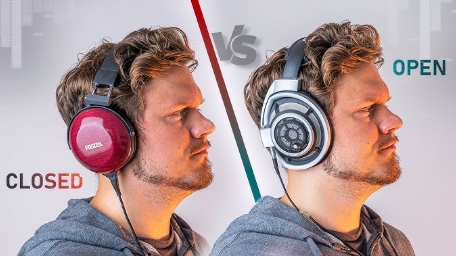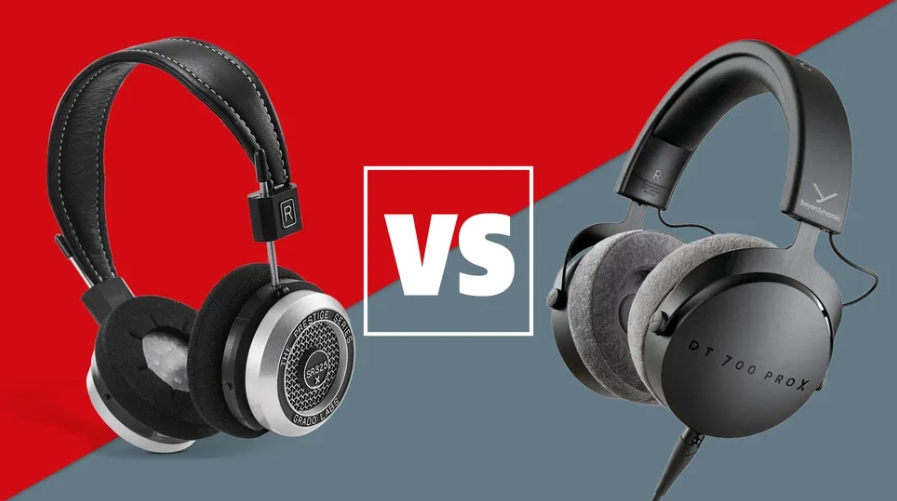
Audiophile headphones deliver sound with precision and clarity that casual models can't match. These high-fidelity devices are prized for their ability to reveal subtle audio details. One of the most important distinctions in What Are Audiophile Headphones is the design: open-back versus closed-back. This difference impacts everything from soundstage to isolation. Choosing between the two depends on how, where, and why you listen. Understanding their unique characteristics helps ensure you select the best type for your audio preferences and environment.

What Are Open-Back Audiophile Headphones?
Open-back headphones appeal to listeners who want spacious, immersive audio. Let's explore how their design enhances the sound.
Open Design and Airflow Characteristics
Open-back headphones have ear cups designed with vents or grilles that allow air and sound to flow freely. This open structure prevents pressure build-up, resulting in a more natural sound. The design allows ambient noise in and audio to leak out, which enhances realism but reduces isolation. Because of this airflow, the drivers operate with less resonance, helping reduce distortion. These headphones aren’t suitable for noisy places but offer a more transparent, lifelike sound for careful listening.
Natural Soundstage and Listening Experience
Thanks to their open construction, these headphones create a wider, more immersive soundstage. Audio feels like it’s coming from around you, not just from the ear cups. This effect mimics listening to high-end speakers in a room, giving music a spatial quality. Instruments and vocals sound distinct and well-placed, which makes them popular for classical, jazz, or live recordings. They excel in revealing audio nuances, ideal for listeners who prioritize realism and depth in their listening sessions.
Best Environments for Open-Back Use
Open-back headphones work best in quiet, controlled environments like home studios, living rooms, or dedicated listening spaces. Their sound leakage and lack of isolation make them unsuitable for public use or shared spaces. Audiophiles often use them in relaxed settings where ambient noise is minimal. These headphones are ideal for enjoying music without interruptions and for mixing or mastering audio tracks where accurate spatial cues and natural tonality are critical for the final sound presentation.
What Are Closed-Back Audiophile Headphones?
Closed-back headphones offer a more intimate, isolated listening experience. Here’s why many listeners prefer their focused sound.
Sealed Design and Noise Isolation Benefits
Closed-back headphones feature fully enclosed ear cups that block outside noise and prevent sound from leaking. This sealed design isolates your audio, making it perfect for use in noisy environments or around others. The ear cups create a barrier that enhances passive noise cancellation. Whether you're in a bustling office or commuting, these headphones help maintain privacy and concentration. Their design supports immersive listening without distraction, ideal for focused tasks or enjoying music without disturbing people nearby.
Enhanced Bass Response and Focused Sound
Closed-back models typically produce more pronounced bass and a tighter, more direct sound. The sealed environment allows drivers to build low-frequency pressure effectively, which enhances bass impact. This type of tuning makes them popular for genres like hip-hop, EDM, or rock, where punchy lows matter. The focused sound reduces external distractions and helps isolate details in recordings. While the soundstage isn’t as wide as open-back models, the detail and clarity remain strong, especially in well-engineered headphones.
Ideal Use Cases for Closed-Back Models
Closed-back headphones are ideal for commuting, office use, studio recording, and casual listening in public. Their noise isolation benefits podcasters, musicians recording vocals, or anyone needing minimal sound leakage. They’re also great for gaming or video calls, where focus and minimal background noise are key. These models suit environments where you don’t want to disturb others or be disturbed yourself. Their versatility and privacy make them a top choice for users who need flexibility across different locations.
Key Differences in Listening Experience
Both designs serve different needs. Let’s break down the major contrasts that shape your listening experience.
Soundstage, Imaging, and Acoustic Space
Open-back headphones create a wider, more three-dimensional soundstage. You’ll hear instruments and vocals placed across a natural acoustic space, which enhances realism. Closed-back headphones, on the other hand, produce a narrower but more concentrated sound image. While they might not replicate room-like acoustics, they offer clarity and directionality that suits focused listening. The key trade-off lies in openness versus intimacy—open-back excels in atmospheric detail, while closed-back emphasizes precision within a tighter sonic environment.

Ambient Noise Handling and Privacy
Open-back headphones let external sounds in and audio out, offering no real isolation. This makes them impractical for use in noisy or shared spaces. Closed-back headphones shine in these situations, blocking environmental sounds and preventing audio leakage. If privacy or minimal disturbance is important—like during flights, commuting, or working near others—closed-back is the clear winner. Each design’s ability to handle ambient noise affects where and how you can use them effectively without compromising listening quality.
Comfort and Listening Fatigue Over Time
Open-back headphones generally offer better airflow and lighter weight, reducing heat buildup and making them more comfortable during long sessions. Their breathable design prevents sweaty ears and pressure build-up. Closed-back headphones may feel warmer due to their sealed ear cups but often include plush padding to compensate. Listening fatigue varies depending on the headphone quality and fit, though open-back models tend to feel more natural over time. Choosing well-cushioned models in either style helps prevent long-term discomfort.
Which One Should You Choose?
Selecting the right headphones depends on your lifestyle, listening goals, and acoustic preferences. Here’s how to decide.
Match Headphones to Your Listening Environment
Consider where you’ll use your headphones most. If it’s a quiet room at home or a studio, open-back models deliver immersive, realistic sound. But if you’re often in public spaces, traveling, or working near others, closed-back headphones offer the privacy and isolation you need. Your environment plays a significant role in shaping your audio experience. Matching headphone design to your typical surroundings ensures you get the most out of your listening time with minimal compromise.
Consider Genre, Use Purpose, and Preferences
Your music taste and use case matter. Open-back headphones suit acoustic, classical, or orchestral genres where space and detail matter. Closed-back models complement bass-heavy or pop music and are useful for voice work, recording, or casual listening. If you're mixing music, an open-back pair might serve best. For recording or private sessions, closed-back headphones are ideal. Understanding your primary use—whether critical listening, content creation, or leisure—guides your choice toward the headphones that match your expectations.
Balance Between Portability and Sound Accuracy
Open-back headphones aren’t travel-friendly due to their sound leakage and lack of noise isolation. They also tend to be bulkier. Closed-back designs excel in portability, often featuring foldable frames or rugged builds suited for mobile use. However, if ultimate sound accuracy and an expansive soundstage matter more than portability, open-back might be worth the trade-off. Balancing convenience and fidelity is key—choose what best fits your daily routine and sound quality priorities for the best headphone experience.
Conclusion
Understanding the difference between open-back and closed-back audiophile headphones helps you choose what best fits your lifestyle and sound preferences. Open-back offers realism and depth for quiet, immersive sessions, while closed-back provides isolation and punch for active or public environments. Both styles have their strengths, and the right choice depends on your setting, music taste, and audio expectations. Whether you're a casual listener or a dedicated audiophile, picking the proper headphone type ensures a richer, more satisfying experience.
FAQ
Open-back headphones are excellent for mixing and mastering due to their natural soundstage and accurate imaging. They provide an open, realistic listening experience that helps producers make precise adjustments. However, for tracking vocals or instruments, closed-back headphones are preferable to prevent sound bleed into microphones.
Some users may experience listening fatigue with closed-back headphones, especially during long sessions, due to heat buildup and internal pressure. Choosing models with breathable padding and a balanced sound signature can reduce fatigue. High-quality closed-back designs minimize this issue significantly.
Many audiophile headphones, whether open-back or closed-back, benefit from headphone amps, especially if they have high impedance. An amp provides the necessary power for optimal performance, enhancing clarity, dynamics, and detail. Check your headphone’s specifications and pair it with an amp if your audio source lacks sufficient output power.